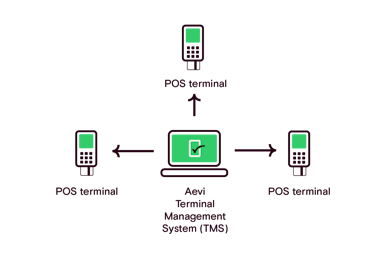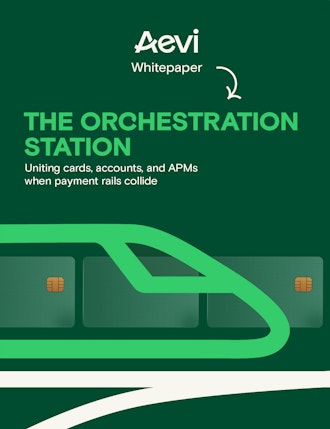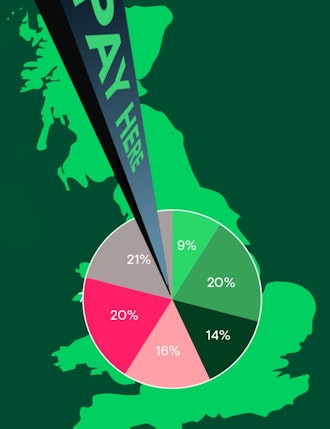What payment enablers need to know about terminal management systems and how they benefit merchants

Key Insights
-
The most important thing to understand about a Terminal Management System (TMS) is that it acts as mission control for merchant terminals, reducing downtime and keeping payments secure, compliant, and always-on.
-
One of the lesser-known advantages is cost efficiency: TMS cuts site visits and manual fixes, while visibly improving merchant satisfaction.
-
What many enablers underestimate is how TMS becomes a strategic differentiator, turning reactive troubleshooting into proactive merchant partnership.
-
The key trend to watch is orchestration-first platforms like Aevi, unifying multi-vendor fleets, security, and data into one simplified ecosystem.
Don't have time to read more now? Sign up to our newsletter to get the latest insights directly in your inbox.
So, what happens when the tills go down?
To best understand a Terminal Management System (TMS), think about the checkout lanes in a store and what happens when one or more tills start to fail. One terminal goes offline, another is running outdated software, and a third is missing critical security patches. The store can still trade on the working tills, but every hiccup means bigger queues on the working tills, lost sales from frustrated customers and stressed staff.
Now, scale that problem across hundreds or even thousands of merchants, and the complexity multiplies fast.
That’s where a Terminal Management System comes in…
What is a Terminal Management System?
A TMS is specialized software that acts as the central hub for managing, monitoring, and securing payment terminals. It connects to devices through secure networks, giving payment enablers like ISVs, PSPs, and ISOs full visibility and control without ever needing to touch a single terminal.
Here’s what a TMS means in practice:
- How it works: The TMS communicates with terminals remotely via encrypted connections, APIs, or lightweight device agents.This allows enablers to monitor and manage devices without needing to visit sites.
- Where it lives: Most modern TMS platforms are cloud-based, though some offer hybrid or on-premise options.
- How your merchants get it: Merchants don’t install it themselves, it’s provisioned by their payment provider or enabler as part of their service.
- What it delivers: Remote updates, real-time diagnostics, compliance enforcement, and fraud safeguards, keeping every terminal ready to process payments without disruption.TMS also provides performance insights, supports multiple device types, and helps enablers prevent issues before they affect merchants, turning reactive troubleshooting into proactive support.
- Why it matters: The most important thing to understand is that merchants never interact with the TMS directly. They simply experience terminals that stay updated, secure, and always ready to accept payments. From a single interface, enablers can scale across hundreds or thousands of terminals, ensuring consistent service, faster problem resolution, and a better experience for both merchants and their customers. For payment enablers, it’s the unseen control layer that ensures smooth operations at scale, and therefore the biggest benefit to merchants.

“Our management interfaces keep estates up-to-date, secure and fully transacting, enabling enablers to move beyond reactive troubleshooting and deliver a proactive, consistent experience for merchants across all in-person payment devices.”
Eddie Johnson, CTO at Aevi
How TMS supports merchant relationships
The real value of a TMS is two-fold - it increases operational uptime and how uptime translates into merchant trust, loyalty, and lower service costs. Let’s take a look at these benefits in more detail…
Operational uptime
A TMS slashes downtime. Remote diagnostics and automated alerts mean you can fix issues instantly - no more expensive site visits or merchants waiting with card machines down.
Faster support
The most important signal of merchant trust is how quickly you solve problems. A TMS lets your team troubleshoot in real time, giving merchants the confidence that payments won’t fail at peak moments.
Cost efficiency
One of the lesser-known advantages is how much TMS reduces support costs for enablers. By reducing the need to send technicians on-site, manual interventions, and after-hours emergencies, you save money, while delivering visible savings back to merchants.
Confidence & trust
What many enablers overlook is that TMS is not just about the tech. It’s about building confidence with merchants. They see that their payments are secure, compliant, and always-on. That trust keeps them from shopping around.
Choosing the right TMS for you and your merchants
Not every system is built for scale. Enablers need to evaluate TMS platforms with both merchant expectations and their own growth in mind. At Aevi, we find that considering these 4 points is the best way to decide which TMS is right for you…
Scalability - The most important requirement is that your TMS grows with you. Can it manage thousands of terminals across regions? Does it support new form factors like SmartPOS or tap-to-mobile?
Integration - A strong TMS should plug seamlessly into your existing acquirer, PSP, and orchestration stack. Look for APIs, multi-vendor compatibility, and the ability to manage terminals across different providers from one place.
Usability - One of the lesser-known challenges is operator experience. If your teams struggle with dashboards or workflows, the value of TMS collapses. Role-based views, simple interfaces, and remote assist tools keep your support team efficient.
Security - What many enablers underestimate is the compliance burden. A TMS helps ensure PCI DSS compliance, enforces encryption, and handles remote key injection at scale, serving as wonderful peace of mind.
Proactive insights - Beyond resolving issues, a TMS should surface analytics and alerts that anticipate problems before they impact merchants. This shifts enablers from reactive troubleshooters to proactive partners who help merchants stay ahead.
Consistency across estates - Managing multiple devices and locations from one platform means merchants get the same reliable performance wherever they operate. That consistency strengthens trust and simplifies growth planning.
With friction minimized, merchants can scale confidently, knowing their payments and support infrastructure will keep pace. For enablers, that reinforces the role as both a service provider and a long-term partner in growth.
A glimpse into the future of terminal management…
The key trend to watch is the move from device-level fixes to orchestration-first platforms. Instead of siloed tools, enablers are turning to solutions that unify everything - terminals, providers, and data - into one view.
Our very own Sarah Koch, Director of Marketing and Communications at Aevi shares her thoughts on what we believe the future will hold for TMS…
"We believe AI-driven diagnostics will become central to terminal management. They’ll help enablers catch issues early - from unusual transaction patterns to signs of device tampering - before merchants are even aware there’s a problem.
Looking ahead, the most important defence will be continuous security, with PCI DSS 4.0, zero-trust controls, and remote patching becoming standard. And as more device types come into play - countertop, mobile POS, tap-to-mobile - unified management through a single orchestration layer will be what keeps it all manageable.
That’s where Aevi’s platform fits: connecting any terminal, any vendor, any market, and making sure merchants stay up and running."
The next wave of terminal management is already here. Connect with Aevi to unify devices, strengthen security, and keep your merchants confident at the point of sale. Let’s talk.











